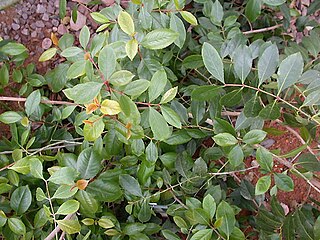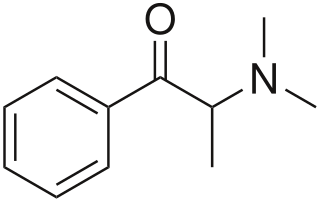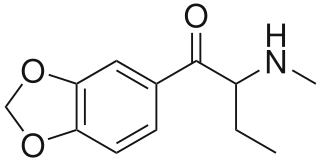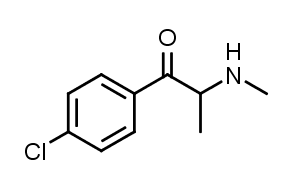
Khat or qat is a flowering plant native to eastern and southern Africa. Khat contains the alkaloid cathinone, a stimulant, which is said to cause excitement, loss of appetite, and euphoria. Among communities from the areas where the plant is native, khat chewing has a history as a social custom dating back thousands of years analogous to the use of coca leaves in South America and betel nut in Asia.

D-norpseudoephedrine, also known as cathine and (+)-norpseudoephedrine, is a psychoactive drug of the phenethylamine and amphetamine chemical classes which acts as a stimulant. Along with cathinone, it is found naturally in Catha edulis (khat), and contributes to its overall effects. It has approximately 7-10% the potency of amphetamine.

Cathinone is a monoamine alkaloid found in the shrub Catha edulis (khat) and is chemically similar to ephedrine, cathine, methcathinone and other amphetamines. It is probably the main contributor to the stimulant effect of Catha edulis, also known as khat. Cathinone differs from many other amphetamines in that it has a ketone functional group. Other phenethylamines that share this structure include the stimulants methcathinone, MDPV, mephedrone and the antidepressant bupropion.

Metamfepramone is a stimulant drug of the phenethylamine, and cathinone chemical classes. Dimethylcathinone was evaluated as an appetite suppressant and for the treatment of hypotension, but was never widely marketed.

Butylone, also known as β-keto-N-methylbenzodioxolylbutanamine (βk-MBDB), is an entactogen, psychedelic, and stimulant psychoactive drug of the phenethylamine chemical class. It is the β-keto analogue of MBDB and the substituted methylenedioxyphenethylamine analogue of buphedrone.

4'-Methyl-α-pyrrolidinopropiophenone is a stimulant drug and substituted cathinone. It is structurally very similar to α-PPP, with only one added methyl group in the para position on the phenyl ring. 4-MePPP was sold in Germany as a designer drug in the late 1990s and early 2000s, along with a number of other pyrrolidinophenone derivatives. Although it has never achieved the same international popularity as its better-known relations α-PPP and MDPV, 4-MePPP is still sometimes found as an ingredient of grey-market "bath salt" blends such as "NRG-3".

Flephedrone, also known as 4-fluoromethcathinone (4-FMC), is a stimulant drug of the cathinone chemical class that has been sold online as a designer drug starting in 2008.

α-Pyrrolidinopentiophenone is a synthetic stimulant of the cathinone class developed in the 1960s that has been sold as a designer drug. Colloquially, it is sometimes called flakka. α-PVP is chemically related to pyrovalerone and is the ketone analog of prolintane.

Substituted cathinones, which include some stimulants and entactogens, are derivatives of cathinone. They feature a phenethylamine core with an alkyl group attached to the alpha carbon, and a ketone group attached to the beta carbon, along with additional substitutions. Cathinone occurs naturally in the plant khat whose leaves are chewed as a recreational drug.

3-Fluoromethcathinone is a chemical compound of the phenethylamine, amphetamine, and cathinone classes that has been sold online as a designer drug. It is a structural isomer of flephedrone (4-fluoromethcathinone).

4-Methylethcathinone or 4-MEC is a chemical that bears a chemical resemblance to mephedrone. Due to its similarity to mephedrone, it is thought to be a stimulant and entactogen drug of the phenethylamine, amphetamine, and cathinone chemical classes. It has been marketed alone or in mixtures with other substituted cathinones under the name "NRG-2", although other blends such as "NRG-1" may have been more ambiguous with their ingredients.

Pentedrone is a stimulant of the cathinone class that has been sold as a designer drug and has been found since 2010 as an ingredient in a number of "bath salt" mixes sold as legal highs.
Bath salts are a group of recreational designer drugs. The name derives from instances in which the drugs were disguised as bath salts. The white powder, granules, or crystals often resemble Epsom salts, but differ chemically. The drugs' packaging often states "not for human consumption" in an attempt to circumvent drug prohibition laws. Additionally, they may be mislabeled as plant food, powdered cleaner, and other such products.

N-Ethylbuphedrone is a stimulant of the cathinone class that has been sold as a designer drug. It is the β-ketone analogue of N,alpha-diethylphenylethylamine.

3-Methylmethcathinone, also known as 3-MMC and metaphedrone, is a designer drug from the substituted cathinone family. 3-MMC is closely related in structure to the more commonly known illicit drug mephedrone (4-MMC), and is also illegal in most countries that have banned mephedrone due to 3-MMC being a structural isomer of 4-MMC. However, 3-MMC has still appeared on the recreational drug market as an alternative to mephedrone, and was first identified being sold in Sweden in 2012. Unlike other legal highs 3-MMC was tested and characterized in large mammals, providing much more knowledge about it than is known about other synthetic cathinones. 3-MMC is a monoamine transporter substrate that potently inhibits norepinephrine uptake and displays more pronounced dopaminergic vs. serotonergic activity.

α-Pyrrolidinohexiophenone is a synthetic stimulant drug of the cathinone class developed in the 1960s which has been reported as a novel designer drug.

4-Methylbuphedrone, is a stimulant drug of the cathinone class that has been sold online as a designer drug.

4-Chloromethcathinone is a stimulant drug of the cathinone class that has been sold online as a designer drug.

N-Ethylhexedrone (also known as α-ethylaminocaprophenone, N-ethylnorhexedrone, hexen, and NEH) is a stimulant of the cathinone class that acts as a norepinephrine–dopamine reuptake inhibitor (NDRI) with IC50 values of 0.0978 and 0.0467 μM, respectively. N-Ethylhexedrone was first mentioned in a series of patents by Boehringer Ingelheim in the 1960s which led to the development of the better-known drug methylenedioxypyrovalerone (MDPV). Since the mid-2010s, N-ethylhexedrone has been sold online as a designer drug. In 2018, N-ethylhexedrone was the second most common drug of the cathinone class to be identified in Drug Enforcement Administration seizures.

α-Pyrrolidinoheptaphenone is a designer drug of the pyrrolidinophenone class of cathinones. It is the higher homolog of α-pyrrolidinohexiophenone (α-PHP).


















